#parson-naturalists
Text
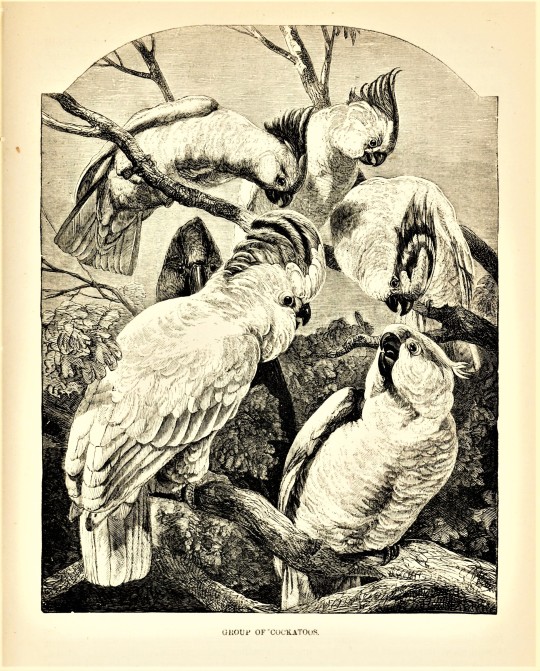

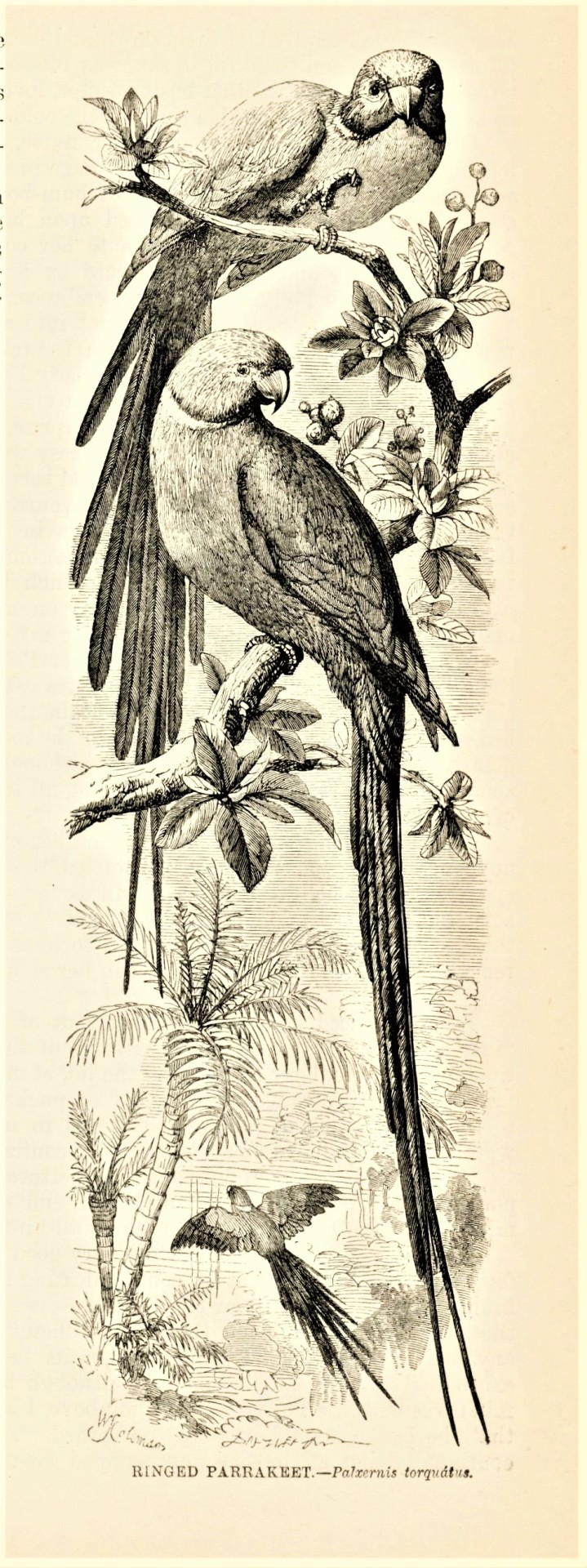

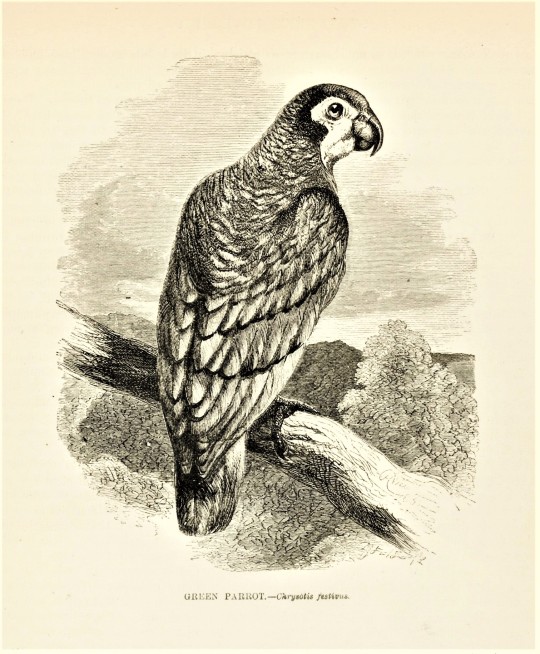





A Feathursday of Wood-Engraved Parrots
This week we showcase some Psittaciformes engraved in wood by the Brothers Dalziel from the Birds volume of The Illustrated Natural History by English natural history writer John George Wood (1827-1889), published in London by George Routledge & Sons in 1865.
J. G. Wood was not a professional zoologist, but rather an ordained priest who relinquished his pastoral duties to become one of the most well-known parson-naturalists of the Victorian era, especially for his numerous publications and his famous public lectures both in Great Britain and America.
The Brothers Dalziel was a prominent family wood-engraving business founded in 1839 by George Dalziel (1815-1902), and composed of four brothers and one sister. The engravings shown here were made from illustrations by several artists, including William Stephen Coleman, Harrison Weir, and T. W. Wood.
View another post with illustrations engraved by the Brothers Dalziel.
View more Feathursday posts.
View moreposts with wood engravings!
#Feathursday#Parrots#Psittaciformes#The Illustrated Natural History#John George Wood#Brothers Dalziel#George Routledge & Sons#parson-naturalists#William Stephen Coleman#Harrison Weir#T. W. Wood#natural history#wood engravings#birds#birbs!
46 notes
·
View notes
Text



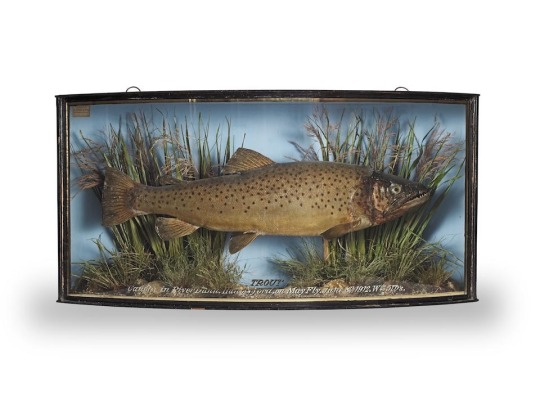





A good collection of nine early to late 20th century stuffed and mounted freshwater fish mounted within glazed presentation cases
all within naturalistic settings with painted backgrounds, eight mounted within bow-fronted cases, some with verre eglomise titles and dates, and one mounted within a rectangular case, comprising a large tench, the cased marked 'THE COMMON', Found dead 19th June 1993, Branston Gravel Pit. Best weight 29lbs 4oz, a small tench, the case marked Tench 4lbs, Caught at Theale by G Krohn 15th July 1934 and further larger tench, the case with paper label to the interior marked CAUGHT AT PERSHORE BY A.J. PARSONS, JULY 25TH 1922, WGT 5LBS, a pair of cased small perch, both with paper labels to the interiors marked 'PERCH CAUGHT ON DEC 3RD 1948 IN THE RIVER BEWDLEY by MR G. HERD. MEMBER OF BIRMINGHAM ANGLING SOCIETY and with further taxidermist labels for E. F. Spicer of Suffolk Street, Birmingham, a larger perch, the case marked Perch 2lbs 8oz. Caught R.E. Wrigglesworth at Thorley Bridge, 'Louth Canal', 9th Sept 1921, and similar perch with paper label to the interior marked 'CAUGHT BY MR F SCHOFIELD, 2 TERRY ST, CARBROOKE, SHEFFIELD, AUGUST 4TH 1903 AT WESBEACH', together with a trout, the case marked 'TROUT' caught in the River Dunn, Hungerford on May Fly, June 8th 1912, wgt 5lbs, and a trout.
Bonhams
143 notes
·
View notes
Text
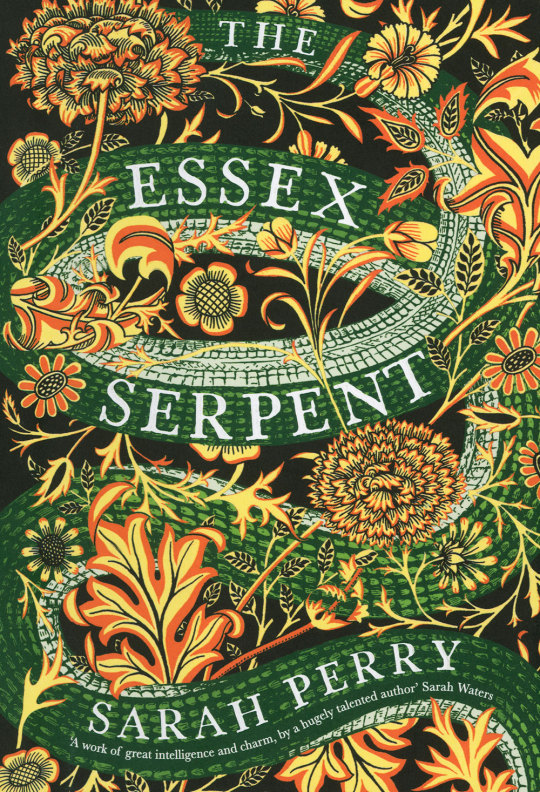


Title: The Essex Serpent
Author: Sarah Perry
Genre/s: historical
Content/Trigger Warnings: emotional and physical abuse, implied death by drowning, implied death in childbirth, implied sexual harassment
Summary (from author's website): London, 1893. When Cora Seaborne's controlling husband dies, she steps into her new life as a widow with as much relief as sadness. Along with her son Francis - a curious, obsessive boy - she leaves town for Essex, in the hope that fresh air and open space will provide refuge.
On arrival, rumours reach them that the mythical Essex Serpent, once said to roam the marshes claiming lives, has returned to the coastal parish of Aldwinter. Cora, a keen amateur naturalist with no patience for superstition, is enthralled, convinced that what the local people think is a magical beast may be a yet-undiscovered species. As she sets out on its trail, she is introduced to William Ransome, Aldwinter's vicar, who is also deeply suspicious of the rumours, but thinks they are a distraction from true faith.
As he tries to calm his parishioners, Will and Cora strike up an intense relationship, and although they agree on absolutely nothing, they find themselves at once drawn together and torn apart, affecting each other in ways that surprise them both.
The Essex Serpent is a celebration of love, and the many different shapes it can take.
Buy Here: https://bookshop.org/p/books/the-essex-serpent-sarah-perry/7213198
Spoiler-Free Review: On the surface, this book is a beautifully deep and detailed historical novel, with all the right period details. It’s also a bit of a mystery/horror novel, with all those tiny nods to the (historical) legend of the Essex Serpent and the touches of folk horror in how the people of Aldwinter talk about it and deal with it.
But at its core, it's all about the characters, who are all quite complex and layered in their portrayals. None of them fits into any sort of stereotype one might find of them in Victorian novels: Cora isn’t necessarily the typical widow (merry or otherwise), William isn’t the typical parson, Martha isn’t the typical lady’s companion, etc. Each character has an idea of what the other characters are like before meeting them, then another idea of what they’re like after meeting them. That idea changes throughout the course of the novel as the plot plays out - a plot that is largely driven by the way the characters interact with each other. There’s a kind of ripple effect: one character takes some kind of action (or doesn’t), and the effects of their action or inaction affects the other characters, to a greater or lesser degree. This is what makes the characters - and the novel - enjoyable to read.
This dynamic is clearest with Cora and William. Initially they have some negative ideas about what the other is like, but when they finally meet each other in person those ideas change, and become more positive. But as the novel goes on, it becomes clear that though they get along and agree on a lot of things, there’s also plenty of things they DON’T agree on - but that just makes them more interesting to each other, more enjoyable to be around. This creates an interesting push-and-pull between them, that ripples out onto the other characters. Those characters, in turn, react to that dynamic, and their reactions spark similar reactions in other characters, including Cora and William.
Of course, none of these dynamics would be interesting if the characters themselves weren’t interesting on their own. As I mentioned earlier, none of the characters are stereotypes, but some are, I think, a bit more interesting than others - largely because of how they shine a light on aspects of British Victorian history that might not always be made obvious in other media based on the time period. The most obvious example here is Martha: her socialist politics provide a refreshing contrast to the politics of the other characters, but her sapphic-coded relationship with Cora, and her more complicated, politically-slanted relationship with Spencer, also add angles and layers to her that are not always visible in media and literature about the Victorian period.
But where does this leave the Essex Serpent itself, and its story? While it’s still a presence in the novel, and is the reason why all the characters come together in the first place, it’s really more of a symbol than any kind of actual threat. In that sense it can be viewed in many different ways, but the one I lean more towards is that it is a symbol of making assumptions, and disillusionment: two things all the characters undergo, for better and for worse.
So overall, while some readers might come to this novel expecting something in the horror or gothic vein (like I did, initially), they’ll quickly come to learn that this really is a story about the characters in it, and how they interact with and react to each other, than about any supposed monster lurking in the river. While this might be disappointing to some readers who were looking for a scarier read, others might find themselves unexpectedly delighted by the novel’s character-heavy focus and the author’s wonderful prose.
Rating: five blue stones
2 notes
·
View notes
Text


14 August 2022 / I did a good bit of wandering around nice fields looking for butterflies while I was home last month.
Today, I’ve managed to finish The English Parson-Naturalist, which was really not what I was hoping it’d be. Too many names and dates, not enough theme. Since my last update, I also spent a lot of time working on materials for the museum and visited the NHM archives again.
Tomorrow, I need to go through all of the photos I took of archival documents and type up my notes on The English Parson-Naturalist.
While I’ll eventually finish reading Ninth House, I really can’t seem to get into it. I did read most of Magic for Liars over the weekend, though.
23 notes
·
View notes
Text
'Mother Play,' Stellar Performances by Celia Keenan-Bolger, Jessica Lange, Jim Parsons
The 'Mother Play' by Paula Vogel is a must-see for its profound themes and especially for its marvelous performances by Jessica Lange, Celia Keenan-Bolger and Jim Parsons.
(L to R): Celia Kennan-Bolger, Jessica Lange in Mother Play (Joan Marcus)
One of the keys to understanding Mother Play, A Play in Five Evictions by Paula Vogel is in the narration. Currently running in its premiere at 2NDSTAGE, directed by Tina Landau, Vogel’s play is has some elements of her own life, by is not naturalistic. It is stylized, quirky, humorous, imaginative and figurative, like…

View On WordPress
#2NDSTAGE#Celia Kennan-Bolger#Christopher Gattelli#Jessica Lange#Jim Parsons#Mother Play#Paula Vogel#Tina Landau
0 notes
Text

Day 36- Film: Clash by Night
Release date: June 16th, 1952.
Studio: RKO
Genre: Drama/noir
Director: Fritz Lang
Producer: Jerry Wald, Norman Krasna, Harriet Parsons
Actors: Barbara Stanwyck, Paul Douglas, Robert Ryan, Marilyn Monroe
Plot Summary: Mae Doyle returns home after 10 years when an illicit romance breaks up. No young woman anymore, she is now bitter and reclusive. When she and childhood friend Jerry begin dating, Mae tries to break it off, saying she would never be a good wife to him. Eventually she gives in and marries him, hoping that she can feel secure and learn to love him. It doesn’t take long for her to tire of his simple pragmatic ways, however. Jerry’s best friend Earl, meanwhile, falls desperately in love/lust with her. Will the temptation be too great to resist?
My Rating (out of five stars): ***½
Damn, until about the last 10 minutes, I was going to give this 4 stars- even though I hated almost all of the characters! The ending nearly completely ruined it, though. Until then it was an unusually cynical and bleak movie for Hollywood in the early 1950s. It seemed obvious that it was an adaptation of a play, which it was, and it seemed obvious that the original ending was changed, which it was. I really struggle to even understand why this was adapted for the screen if a “happy” ending had to be tagged on to it. It completely compromises the entire thing.
The Good:
Barbara Stanwyck was impressive. She is definitely of the old school acting style, before the more naturalistic style we’re used to today became prevalent. Even so, I thought her performance was very effective. And my god, she played bitter and jaded well here! She gave me chills sometimes.
Paul Douglas was also wonderful. A Letter to Three Wives is one of my favorite films, and I fell in love with him in that. He plays earnest everyman characters so well, and he’s always so likeable. His character in this is a bit weak and gullible, but also a genuinely good person.
The main love triangle in this is between people who are all in their 40s! That is exceedingly rare for a Hollywood film even today. I loved the way that added a different layer of maturity and complexity.
A lot of dialogue was really good, again, so no surprise that it came from a play. I usually try to jot down interesting quotes while I watch a movie, and there were so many, I kept having to pause this to get things written down.
The cynicism and darkness were pervasive and engulfing. There was a kind of claustrophobia in all three of the main characters' lives, and it really made you feel trapped in a kind of hell with them.
I hated so many of the characters, but they were real and made the despair of the story intense. Earl repulsed me on a physical level- I could barely stand to watch him. Mae was not a good person either. Jerry had a mooching uncle that I could barely stand. Even Jerry himself, generally being a good guy, was a bit annoying in how much he tolerated being around these terrible people.
The Bad:
The ending! The ending! I don’t know if I could ever tire of ranting about how stupid the ending was. Spoiler ahead: When Mae suddenly decided out of nowhere that she should go back to Jerry, it was ridiculous and totally out of character. When Jerry takes her back, I even said out loud, “Well, this will probably last a week!” Nothing about the film made sense with this kind of ending.
Hating so many characters was a plus and a minus. The minus was that it made the movie hard to sit though at times. I could care less what happened to Earl or Uncle Vince or even Mae.
If I didn’t hate Earl enough, he had a whole repeating segment about doing his “Chinese impression,” where he pulled at his eyes and made strange noises that sounded nothing like Chinese. I am SO SICK of these scenes in movies, radio, and tv shows! I hope they get less frequent as the project goes on, because I’m barely more than 1/3 finished.
0 notes
Text
Music Monday: Top songs of the Week!

Adam Humphries, the editor of WhatsOn, has compiled this week's top songs. There is something magical about music that can revitalize and cure the soul while also igniting new hope. Here is the weekly music selection for you to enjoy and add to your playlist.
School of X's Rasmus Littauer features on wicked THE ADAM debut! - Geronimo
Hailing all the way from Copenhagen, yet was a huge love for British artists such as John Lennon and Jimi Hendrix, the Adam, fronted by lead singer Adam Olssen homage 2 British rock greatness in his debut. Accompanying him is Danish singer-songwriter, Rasmus Littauer.
The irony behind this upcoming EP came from Adam's own interpretation of how many amazing rock bands seem to develop or end up; making a couple of great records and someone is the leaves or band breaks up. Considering this is his debut into the British music scene only time will tell if this could happen.
By the way for debuts, this song that is actually quite impressive and you can definitely hear the Lennon/Hendrix sound here.
https://open.spotify.com/track/3mYWazxWd9hcgbIrdFGFCt?si=xG1_Y33PSUmgSSgaxaRgeA&utm_source=copy-link
When it comes to music videos there's always something both naturalistic and warming when it looks like it's been recorded in a sound studio. Gives it that band harmony feel.
https://youtu.be/BVWhioZIxng
American underground artist - Tod Lippy releases "Time," his cover of the 1981 hit by Alan Parsons Project
American underground artist, Tod Lippy, has done a cover of a classic 1981 track from the Alan Parsons Project, and credit where it's due, he has managed to completely reinvent it. The original author of a gospel folk-rock sound and where it is in these new ones Todd lippy has made it more of an electronic, indie, ambient sound. He's also taken it in a completely different direction and has made this version seem darker as compared to its original counterpart.
Now when it comes to remakes, especially for singer-songwriters and musicians you can I can either add more to the song or can reinvent it. The real trick is not to a complete copy which is a few bits added to it. In this version, Lippy has got for a complete reinvention
https://open.spotify.com/track/56HabXWN78TrGRfDnjXxS6?si=iY3NJ1kcQzKl5e3hbOYc-g&utm_source=copy-link
In both versions the song is about existence, yet to wear Alan Parsons was more updated Lippy's is more dark and somber
https://youtu.be/XXigP1d1plo
"Goodbye my love/maybe for forever"
MAIA BAROUH invites you into her delicious sound world with the new album - “AIDA”, out on 21st October!
Every so often you get those songs that surprise you in a way that you weren't entirely expecting, and this is one of those. Half French half Filipino, Maia, certainly delivers that in a very thought-provoking way. Maia draws heavily on her heritage when it comes to her music and art. She draws on electronic grooves, instrumental, French cinema, Japanese underground art, national folk rap, and dance grooves. Also being the daughter of known French cinematographer, Pierre Barough.
https://open.spotify.com/track/2oazbAJWVJLvzoA4eiHzm4?si=mAvpvBl6Rzi1IoHUVrntjQ&utm_source=copy-link
In her lyrics, she draws heavily on the subject issues such as racism, anti-feminism as well as xenophobia. A video for the song draws heavily on the underground scene, especially of the Japanese underground scene. Maia is definitely one of those artists to keep your eye and ear out for, and fearlessly uses her art and music to convey a message
https://youtu.be/vwv3AuBTTPw
Hannah Schneider - releases her first solo album in 7 years, 'Ocean Letters'!
Danish singer-songwriter and musician, Hannah Schneider, is back after a 7-year-old break from music, and by the looks of things, she's been very busy. She releases her upcoming EP, ocean Letter. The album consists of 10 tracks of her reflecting on her life as well as a return to her classical roots. With some electronic and ambient sounds thrown into the mix.
The album was written during the pandemic, which is where many of us were left dealing with our own problems. As many great artists normally do, Hannah has taken these experiences and channeled them into her songwriting.
The result is this amazing album.
https://open.spotify.com/album/2zScA0GhvQ7bpWAGWMeEmx?si=VXTtbR0KRm6lUYdADrhgnA&utm_source=copy-link
In a similar way to Kate Bush, Hannah hasn't rushed when it comes to making this album she has just taken her time. Ironically, this is where we seem to get the best of their work and Hannah is one of those artists.
Just take your pick and listen
https://youtube.com/playlist?list=OLAK5uy_n_YbacL4MGirtQpmtDNw_X8mB9S9deTj8
Read the full article
1 note
·
View note
Photo

“When we find out that an assertion is a falsehood, a shining truth takes its place, and we need not fear the destruction of the false. The more false we destroy the more room there will be for the true.
There was a time when the astrologer sought to read in the stars the fate of men and nations. The astrologer has faded from the world, but the astronomer has taken his place.
There was a time when the poor alchemist, bent and wrinkled and old, over his crucible, endeavored to find some secret by which he could change the baser metals into purest gold. The alchemist is gone; the chemist took his place; and, although he finds nothing to change metals into gold, he finds something that covers the earth with wealth.
There was a time when the soothsayer and auger flourished, and after them came the parson and the priest; and the parson and priest must go. The preacher must go, and in his place must come the teacher—that real interpreter of nature. We are done with the supernatural. We are through with the miraculous and the wonderful.
There was once a prophet who pretended to read in the book of the future. His place was taken by the philosopher, who reasons from cause to effect—a man who finds the facts by which he is surrounded and endeavors to reason from these premises, and to tell what in all probability will happen in the future. The prophet is gone, the philosopher is here.
There was a time when man sought aid entirely from heaven—when he prayed to the deaf sky. There was a time when the world depended upon the supernaturalist. That time in Christendom has passed. We now depend upon the naturalist—not upon the disciple of faith, but upon the discoverer of facts—upon the demonstrator of truth. At last we are beginning to build upon a solid foundation, and just as we progress the supernatural must die.
Religion of the supernatural kind will fade from this world, and in its place we will have reason. In the place of the worship of something we know not of, will be the religion of mutual love and assistance—the great religion of reciprocity. Superstition must go. Science will remain. The church, however, dies a little hard. The brain of the world is not yet developed.”
-- Robert Green Ingersoll
#Robert G. Ingersoll#Robert Ingersoll#Robert Green Ingersoll#truth vs lies#lies vs truth#truth#philosophy#science#superstition#supernatural#supernatural vs natural#natural vs supernatural#natural world#religion is a mental illness
82 notes
·
View notes
Photo
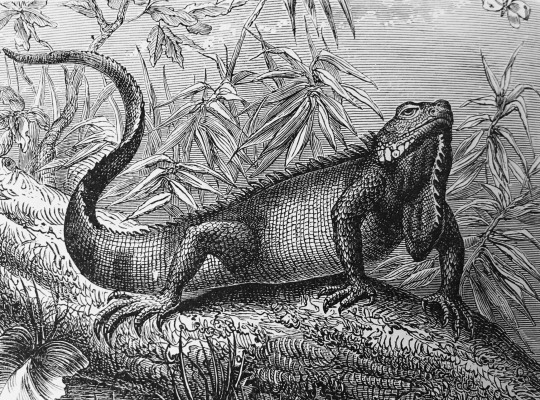
Happy National Iguana Awareness Day!
The Victorian parson-naturalist John George Wood describes the reptile paradoxically in his popular natural history: “This conspicuous—and, in spite of its rather repulsive shape, really handsome—Lizard is a native of Brazil, Cayenne, the Bahamas, and neighboring localities.”
Iguanas are known for their dewlapped skin and spiny backs, but they are also among the few reptile species that possess a third eye. Their parietal eye, located at the top of their heads, can’t see colors or shapes but can detect light and motion.
Images from: Wood, J.G. Wood’s Natural History: Comprising Mammals, Birds, Reptiles and Fishes. Philadelphia: John C. Winston, 1923.
Call number: QL50 .W878 1923
Catalog record: https://bit.ly/3jTOnL4
5 notes
·
View notes
Photo

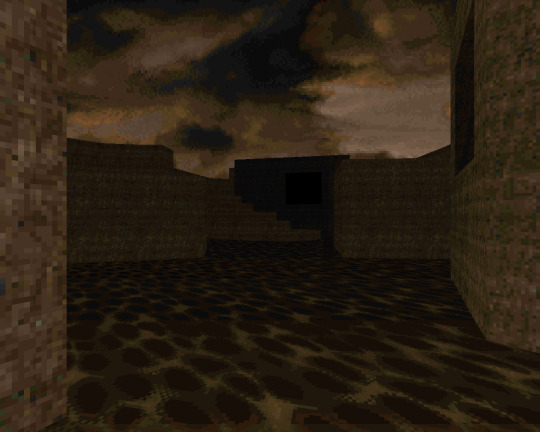



World’s End
Game: Doom II
Year: 2002
Source Port: Limit-removing (but recommended without infinitely tall actors)
Specs: MAP01
Gameplay Mods: None
Author: Alex Parsons
idgames | onemandoom
The texture scheme makes this cooler to look at on the automap than in a selection of screenshots. If you can get past the deathly dull brown then you can enjoy Alex’s unique sort of iterative architecture, particularly as it applies to something like a naturalistic setting. This is the beginning of his World’s End series, named not because of an event in the story but because it represents a locale on something like a Dungeons & Dragons map of the realm. It primarily consists of shotgunning imps in dirty brown water with a Hell knight or two mixed up in there.
Click here if you’d like to read my full review.
#doom#games#game mods#retro gaming#retrogaming#doom WAD#doom mod#screenshot#gallery#review#Doom II#2002#limit-removing#World's End#AP_001#World's End series
9 notes
·
View notes
Text
House of Cods
In recognition of Smithsonian’s Earth Optimism Digital Summit (April 22 – 26, 2020), this week’s post features a work from the Design Library, focused on environmental issues.
The artist’s book, House of Cods, published by Linda Smith and Picnic Press in 1996, presents an engaging use of the book as a form of artistic expression, here addressing the environmental impact of overfishing. Smith, a book artist, designed, printed, and assembled the publication, featuring the poem House of Cods, by Carol Schatt. The tongue–in-cheek title offers an amusing play on words and pronunciation with a Massachusetts accent (“cods” instead of “cards”), while the serious-minded text speaks of the delicate marine ecosystem and the consequences of fishing on an unsustainable commercial scale.
Smith reinforces the massage through her use of both naturalistic and fanciful imagery and imaginative paper construction. She embellished the book’s cover with two naturalistic printed images of fish in rainbow colors. Smith created the images using the traditional Japanese printing technique called gyotaku, in which an actual fish or other sea creature is used as a “printing plate” to make a detailed impression of the animal directly from nature. This form of printing creates a unique image that would be challenging to make with conventional techniques such as wood block printing or etching. Smith printed her gyotaku fish impressions on various Mexican, Philippine, and Thai handmade papers.
Book Cover: House of Cods, Linda Smith, published 1996, printed paper, gyotako technique. Smithsonian Libraries, N7433.4.S658 H68 19
The book opens to reveal an intricate paper pop-up structure that takes the form of a commercial fishing trawler perched on a house of cards. The boat, named “The Joker’s Wild,” is constructed of black and white paper, its net cascading down its sides onto the colorful, boxy card structure below. Smith continues the joker theme in the motif on the cards, where the joker is represented by the image of a fish wearing a jester’s cap. The house of cards is delicately balanced on a short, rectangular paper support printed with images that recall the lifelike fish impressions on the book’s cover. This three–dimensional paper art sits on pages printed with the image of netting overlapping the text of Schatt’s poem lamenting the destructive consequences of overfishing, from the point of view of a cod.
Smith produced fifty copies of House of Cods. Many are housed in library collections across the country, raising awareness and documenting environmental concerns through art. The copy in the Design Library at Cooper Hewitt is part of the Smithsonian Libraries’ large collection of pop-up and artists’ books. To find out more about these works, please visit http://library.si.edu/collection/artists-books .
Erica M. Schaumberg is a graduate student in the History of Design and Curatorial Studies program offered jointly by Cooper Hewitt and Parsons School of Design. She is also a fellow at the Cooper Hewitt, Smithsonian Design Library.
from Cooper Hewitt, Smithsonian Design Museum https://ift.tt/2xUp9Y9
via IFTTT
2 notes
·
View notes
Text
Essay: To what extent does the idea of the Anthropocene require a new approach to nature conservation?
Essay written as part of the ‘Footprints on a Fragile Planet’ geography course at the University of Adelaide, which I took in semester 1, 2017 during my first year of studying the Bachelor of Environmental Policy and Management.

(Image source. Then Let Us Run (The Sky Is Falling) by Emily Parsons-Lord. What happens when humans can imagine and build a new environment? (...perhaps we already have...) Will it be one modelled on previously held ideas of what ‘nature’ looks and feels like?)
In his time, Charles Darwin’s hypotheses were met with resounding incredulity. Assumed insulting (Castree 2014), the naturalist’s theories as to the origins of species went on to establish an entire branch of science; previously unfathomable. The Anthropocene discussion is also one of origin- this time concerning that of today’s changing climate and its consequences for life on Earth. It is also an idea speculated to become as significant as Darwin’s hypotheses (Castree 2014). According to the Anthropocene, human activity has had an influence on ecosystems since complex civilisations began to develop (Ruddiman 2013). This ‘global geophysical force’ of people began an escalation known as The Great Acceleration during the Industrial Revolution. The epoch is now reaching criticality (Steffen et al. 2007) - if trends continue unabated; the viability of future earthly life is jeopardised (Castree 2014). But the crux of the Anthropocene debate lies within its implications for efforts such as nature conservation. The theory emphasises the impression of all man-made systems on even the most remote ecosystem. Therefore very concepts like ‘nature’ upon which conservation has largely evolved from may require adjustment.
The unsustainability of capitalism (Adams 2013) presents completely undermines the objectives of nature conservation. Capitalism is, of course, entrenched in contemporary western civilisation (Brockington et al. 2011). The Anthropocene theory implies that harnessing capitalism’s aspects as a tool interconnected with humanity may be preferable to demonising it. However, evaluations of a recent capitalist conservation innovation, biodiversity trading, suggest promised diversity outcomes are not delivered (Walker et al. 2009). A result which comes even as the notion “capitalism can and should help save the world” apparently inhabits the conservation movement mainstream (Brockington et al. 2011). This illustrates “conservation’s development paradox”, a problem also evident in projects concerning conservation and poverty alleviation synergy (Adams 2013).
Political theory predicts biodiversity exchange policies- due to the immeasurable and non-interchangeable characteristics of biodiversity- are “more vulnerable to the institutional failings that undermine environmental protection than simple … prohibitions” (Walker et al. 2009). Parallel to the faults of this approach, conservation and poverty alleviation efforts are built around a conventional model of ‘development’ based on capitalist principles, also presenting a problem. The basis of the wider economy is not challenged, and its impacts on conservation not addressed (Adams 2013). Perhaps recognition of human failure to meet conservation targets in the post-Acceleration Anthropocene is needed. In this argument, targets are unapologetically based on the best available science and strictly enforced for the greater good of conservation success (Noss et al. 2015).The “resounding silence” (Adams 2013) regarding the capitalism/conservation relationship is inept in an Anthropocene context, where a system as essential to modern human interaction as the economy must be intrinsically linked to the success of nature conservation.
The unprecedented growth of the human population over the past century demands a close-proximity co-existence of people and nature to ensure conservation. Sudden urbanisation generally creates biotic homogenisation (Mason 2006), yet in some cases - if well designed - the two may complement each other. Although there has been very little research into this relationship, (Mason 2006) such has been found by one UK study. Birdlife on the intensely managed farmland surrounding English towns has been in major decline in recent decades, and it has been found that species numbers and richness are both superior in built environments (Mason 2006). Benefits to birds of living in urban development far outweigh those of living on farmland. This is important information considering the country has large future development plans including the creation of new towns in order to accommodate its increasing population (Mason 2006). Still, we must be wary of merely refashioning conservation in the name of the Anthropocene to primarily suit a human-focussed agenda (Doak et al. 2015). Perhaps our entire conception of animal’s sentience and intelligence as fellow life forms needs to be defied (Tobias 2017).True synthesis of human and animal habitat is an idea with unexplored potential to be approached with greater ambition by conservation efforts.
The displacement of indigenous peoples in an attempt to create nature reserves understandably often leads to political tension (Igoe 2002). A case study from Simanjiro, Tanzania analysed conservation efforts targeting the local community. These claimed to give rural Tanzanians “direct control of natural resources [in national parks], thereby creating incentives for sustainable resource management at the community level” (Igoe 2002). Nevertheless, in practise the government-enforced program displayed fundamental misunderstandings of the local Maasai people’s resource management systems (by limiting legal uses of park land) and traditional cultural concepts. The government program, like many, presumes the existence of a fixed nature; able to be preserved by enclosure- a nature non-existent in the Anthropocene (Adams 2013). Community conservation must address the social and ecological impacts on rural communities of national parks. The study stated that it was important to acknowledge that in Tanzania; community conservation is a political proposition (Igoe 2002). Indeed, the exclusion of indigenous communities which have often successfully managed their native land for thousands of years exposes political flaws of nature conservation. It creates one ‘us’ –a responsible species, masking differential human and institutional failures (Adams 2013). Although all human lifestyles have the power to modify the environment in the Anthropocene, nuance as to what choices caused the dangerous Great Acceleration conditions must be acknowledged.
Centralities of environmental thought are obviously being tested by the Anthropocene diagnosis (Lorimer 2015). While current sectors of conservation attempt to involve some Anthropocene implications in an effort to solve human and environmental issues mutually, major flaws are identifiable. These involve a) a lack of constructive criticism of the unsustainable global economic system, b) a lack of serious research regarding how biodiversity may be combined in built environments, and c) a need for greater sensitivity and accommodation of traditional land users. Most notably, the Anthropocene idea challenges some fundamental assumptions of conventional nature conservation philosophy. ‘Nature’ is ambiguous and multilayered. A fine line exists between delivering a much needed jolt to environmental thinking and validating complacency with our discovered ‘human power’ over Earth’s future. The powerful proposal of the Anthropocene will hopefully be remembered as part of the jolt.
Reference List
- Adams, WM 2013, ‘Conservation in the Anthropocene: Biodiversity, Poverty and Sustainability’ in D Roe, J Elliott, C Sandbrook & M Walpole (eds), Biodiversity Conservation and Poverty Alleviation, Wiley-Blackwell, West Sussex, pp. 304-315.
- Brockington, D & Duffy, R 2011, ‘Introduction: Capitalism and Conservation: The Production and Reproduction of Biodiversity Conservation’ in D Brockington and R Duffy (eds), Capitalism and Conservation, Wiley-Blackwell, West Sussex, pp. 1-16, viewed 7 April 2017, <http://au.wiley.com/WileyCDA/WileyTitle/productCd-144433834X.html>
- Castree, N 2014, ‘The Anthropocene and Geography I: The Back Story’ Geography Compass vol. 8, no. 7, pp. 436-449, viewed 7 April 2017, <http://onlinelibrary.wiley.com/doi/10.1111/gec3.12141/abstract>
- Doak, DF, Bakker, VJ, Goldstein, BE & Hale, B, 2015, ‘What Is the Future of Conservation?’ in G Wuerthner, E Crist & T Butler (eds), Protecting the Wild: Parks and Wilderness, the Foundation for Conservation, Island Press, Washington, pp. 27-35, viewed 7 Apr 2017, <https://islandpress.org/book/protecting-the-wild>
- Igoe, J 2002, ‘National Parks and Human Ecosystems: The Challenge to Community Conservation, A Case Study from Simanjiro, Tanzania’ in D Chatty & M Colchester (eds), Conservation and Mobile Indigenous Peoples, Studies in Forced Migration vol. 10, Berghahn Books, Oxford, pp. 77-96.
- Kidner, DW 2014, ‘The Conceptual Assassination of Wilderness’ in G Wuerthner, E Crist & T Butler (eds), Keeping the Wild: Against the Domestication of Earth, Island Press, Washington, pp. 10-15.
- Lorimer, J 2015, Wildlife in the Anthropocene, University of Minnesota Press, Minneapolis, viewed 7 April 2017, <https://www.upress.umn.edu/book-division/books/wildlife-in-the-anthropocene>
- Mason, CF 2006, ‘Avian species richness and numbers in the built environment: can new housing developments be good for birds?’, in DL Hawksworth and AT Bull (eds), Human Exploitation and Biodiversity Conservation, Topics in Biodiversity Conservation vol. 2, Springer, Dordrecht, pp. 25-38, viewed 7 April 2017, <http://www.springer.com/gp/book/9781402052828>
- Noss, RF, Dobson, AP, Baldwin, R, Beier, P, Davis, CR, DellaSala, DA, Francis, J, Locke, H, Nowak, K, Lopez, R, Reining, C, Trombulak, SC, & Tabor G, 2015, ‘Bolder Thinking for Conservation’ in G Wuerthner, E Crist & T Butler (eds), Protecting the Wild: Parks and Wilderness, the Foundation for Conservation, Island Press, Washington, pp. 16-20, viewed 7 Apr 2017, <https://islandpress.org/book/protecting-the-wild>
- Ruddiman, WF 2013, ‘The Anthropocene’ Annual Review of Earth and Planetary Sciences, vol. 41, pp. 45-68 viewed 7 April 2017, <http://www.annualreviews.org/doi/abs/10.1146/annurev-earth-050212-123944>
- Steffen, W, Crutzen, PJ & McNeill, JR 2007, ‘The Anthropocene: Are humans now overwhelming the great forces of nature?’ AMBIO, vol. 36, no. 8, pp. 614-621, viewed 7 April 2017,<http://www.bioone.org/doi/abs/10.1579/00447447(2007)36%5B614%3ATAAHNO%5D2.0.CO%3B2>
- Tobias, MC & Morrison, JG 2017, Anthrozoology: Embracing Co-Existence in the Anthropocene, Springer, Dordrecht, pp. v-xvii, viewed 7 April 2017, <http://www.springer.com/gp/book/9783319459639>
- Walker, S, Brower, AL, Stephens, RT & Lee, WG 2009, ‘Why bartering biodiversity fails’, Conservation Letters, vol. 2, pp. 149-157, viewed 7 April 2017, <http://onlinelibrary.wiley.com/doi/10.1111/j.1755-263X.2009.00061.x/abstract>
#nature#anthropocene#essay#university#conservation#nature conservation#study#climate change#environmentalism#capitalism#tanzania#UK#england#writing#blog#academic
1 note
·
View note
Photo
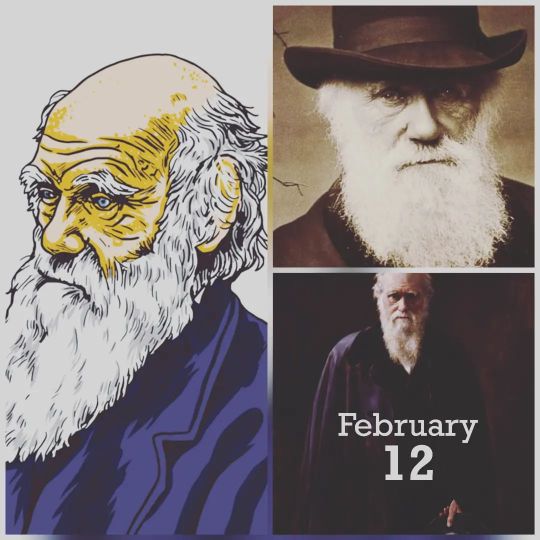
Whether you’re a seasoned scientist who doesn’t mind getting your hands dirty or the thought of math and dissection makes you blanch, on Darwin Day on February 12 we celebrate Charles Darwin’s work and science in general. Take the extra time to learn about his experiments, findings, and accomplishments, and reflect on how they still affect us today. The discovery of evolutionary creation has led scientists across multiple fields to make life-altering and life-saving discoveries about our species and how we originated. There’s a lot to be grateful about for Darwin and his research! Charles Darwin, the man who would come to be known as the father of natural selection, was born on February 12, 1809, the fifth of six children in a wealthy English family. His father was a doctor, and his grandfathers were naturalists who laid the groundwork for the discoveries that Charles would go on to make. In 1825, Charles, who had been helping his father to care for the poor and sick in Shropshire, left for medical school. He found it dull and his studies lacked effort. It wasn’t long until his father sent him to Christ’s College in Cambridge to become an Anglican parson. Though he was on a religious course of study, Darwin found himself drawn to natural sciences. A friend at the time got him interested in beetle collecting and he became acquainted with other parson naturalists who spurred his interest even more. He positioned himself to join his professor on a trip to the tropics to study natural history. https://www.instagram.com/p/CZ4713BDMpN/?utm_medium=tumblr
0 notes
Text
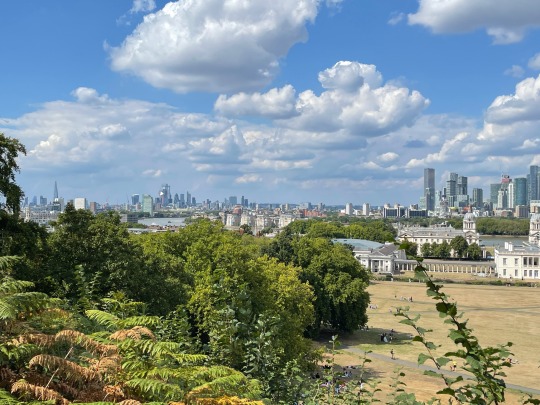
27 August 2022 / Today I went and wandered around Greenwich with a friend and had my first fish and chips since moving here nearly two years ago. I have to go back sometime to actually go into the observatory, but the view was amazing.
Since I last posted, I’ve typed up my notes on The English Parson-Naturalist and pretty much have just been photographing, organizing, and reading documents from the Natural History Museum. I’m (Finally) just about out of material to go see, then I’ll get to writing this chapter for real.
I finished both Magic for Liars and Ninth House (which got way better in the back half, to be honest), and I’m now reading A Brief History of Seven Killings.
10 notes
·
View notes
Text
'Mother Play,' Stellar Performances by Celia Keenan-Bolger, Jessica Lange, Jim Parsons
The 'Mother Play' by Paula Vogel is a must-see for its profound themes and especially for its marvelous performances by Jessica Lange, Celia Keenan-Bolger and Jim Parsons.
(L to R): Celia Kennan-Bolger, Jessica Lange in Mother Play (Joan Marcus)
One of the keys to understanding Mother Play, A Play in Five Evictions by Paula Vogel is in the narration. Currently running in its premiere at 2NDSTAGE, directed by Tina Landau, Vogel’s play is has some elements of her own life, by is not naturalistic. It is stylized, quirky, humorous, imaginative and figurative, like…

View On WordPress
#2NDSTAGE#Celia Kennan-Bolger#Christopher Gattelli#Jessica Lange#Jim Parsons#Mother Play#Paula Vogel#Tina Landau
1 note
·
View note
Quote
The church provided a safe haven for these scientists—but it also effectively neutered their curiosity. The injunctions against the wrong kinds of investigation were so sharp that the parson-naturalists did not even question the myths of creation; it was the perfect separation of church and mental state. The result was a peculiar distortion of the field. Even as taxonomy—the classification of plant and animal species—flourished, inquiries into the origin of living beings were relegated to the forbidden sidelines. Natural history devolved into the study of nature without history. It was this static view of nature that Darwin found troubling. A natural historian should be able to describe the state of the natural world in terms of causes and effects, Darwin reasoned—just as a physicist might describe the motion of a ball in the air. The essence of Darwin’s disruptive genius was his ability to think about nature not as fact—but as process, as progression, as history. It was a quality that he shared with Mendel.
The Gene by Siddhartha Mukherjee
0 notes